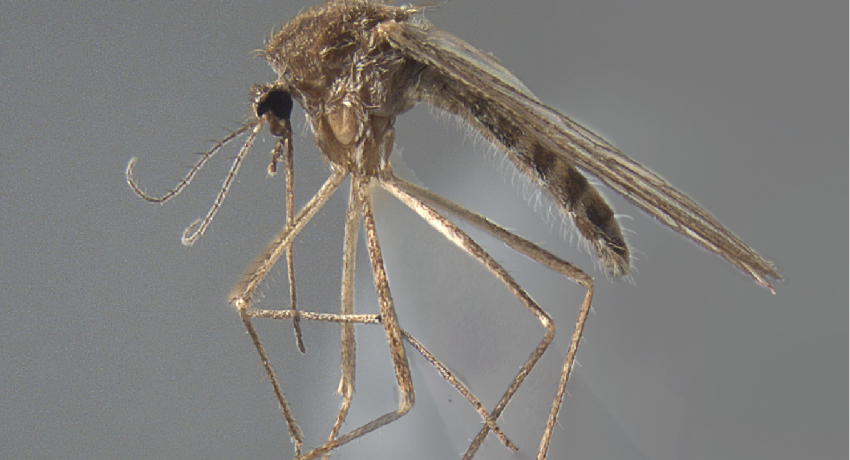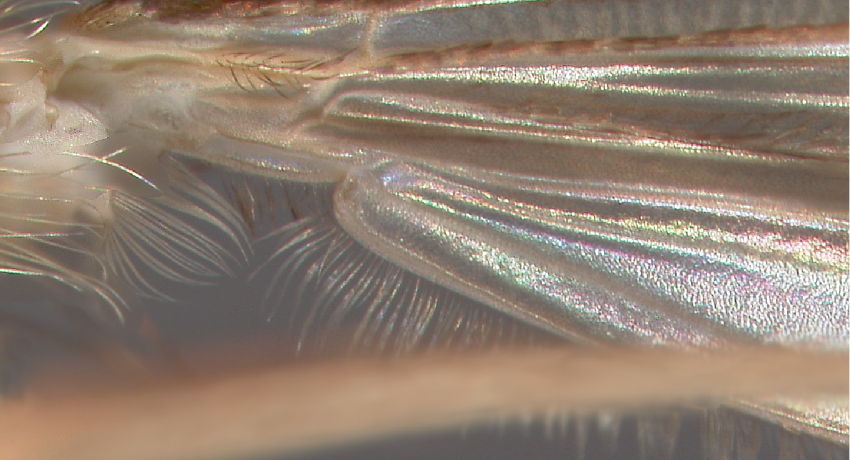AUSTRALASIAN, AFROTROPICAL, NEARCTIC, NEOTROPICAL, ORIENTAL & PALEARCTIC, REGIONS
Generic abbreviation: Cs.
Type species: Culex absobrinus Felt
Etymology: not stated [culi- (posterior) and -seta (hair) (L, Gr); poss. ref. to “Larvae with pecten prolonged into setae…”]
The large mosquitoes of the genus Culiseta superficially resemble the genus Culex, and, in contrast with most groups of mosquitoes, it shows highest diversity in temperate regions. The genus comprises 39 species. Of these, 37 species are subdivided across seven subgenera: Allotheobaldia (one species), Austrotheobaldia (one species), Climacura (six species), Culicella (14 species), Culiseta (12 species), Neotheobaldia (two species), Theomyia (one species), and two species (Cs. arenivaga Marks and Cs. wui Lin, Tseng & Lien) remain unplaced.
DIAGNOSTIC CHARACTERS (Click photos to view; mouse over and click large photo to zoom in.)
ADULT (illustrated): Thorax: Prespiracular setae present; postspiracular area usually without setae or scales; lower mesepimeral setae present. Leg: Pulvillus absent. Wing: Ventral setae present at base of subcosta (except subgenus Theomyia).
LARVA (not illustrated): Larva (head): Hypostomal suture complete. Terminal segments: Seta 5-VIII below dorsal margin of segment X; seta 1-S inserted at base of siphon; seta 4-X usually with ≥3 pairs of setae.
TAXONOMIC KEYS
Barr 1963 (Nearctic)
DuBose & Curtin 1965 (Mediterranean)
Dobrotworsky 1971 (SE Asia)
Tanaka et al. 1979 (Japan & Korea)
Wood et al. 1979 (Canada)
Darsie & Ward 2005 (North America)
Becker et al. 2010 (Europe)
![]()
WRBU – Genera – Global – Larva
![]()
WRBU – Genera – Afrotropical – Adult
![]()
WRBU – Genera – Afrotropical – Larva
![]()
WRBU – Genera – Eastern Palearctic – Adult
![]()
WRBU – Genera – Eastern Palearctic – Larva
![]()
WRBU – Genera – Western Palearctic – Adult
![]()
WRBU – Genera – Western Palearctic – Larva
![]()
WRBU – Genera – Nearctic – Adult
![]()
WRBU – Genera – Nearctic – Larva
![]()
WRBU – Genera – Australasian – Adult
![]()
WRBU – Genera – Australasian – Larva
![]()
WRBU – Genera – IndoMalayan – Adult
![]()
WRBU – Genera – IndoMalayan – Larva
![]()
WRBU – Genera – Oriental – Adult
![]()
WRBU – Genera – Oriental – Larva
![]()
WRBU – Genera – Neotropical – Adult
![]()
WRBU – Genera – Neotropical – Larva
Exemplar DNA sequences
Cs. annulata COI: KX675388–89
Cs. morsitans COI: KU748496, KU748460
Cs. inornata COI: MG087325, MG087024
Cs. subochrea COI: MG962351–52
BIONOMICS
Immatures
Typically Culiseta females oviposit in ponds, marshes, stream edges, ditches, but some species are also found in wells and rockpools. The unusual subgenus Neotheobaldia (restricted to Australasian forests) comprises two species—Cs. frenchii (Theobald, 1901) and Cs. hilli (Edwards, 1926). Neotheobaldia immatures rear in the freshwater collections in underground crayfish tunnels, and pass the winter underground as larvae. Immature of the monotypic subgenus Theomyia (represented by Cs. fraseri (Edwards, 1914)) are found in tree holes in sub-Saharan forests.
Adults
Adult Culiseta feed on a range of hosts, including reptiles, birds, people, and domestic and wild mammals. Several species, particularly the Nearctic Cs. dyari (Coquillett), Cs. inornata (Williston) and Cs. melanura (Coquillett) and the Palearctic Cs. annulata (Schrank) are of biomedical importance.
*Associated pathogens: This list reports bacteria, viruses, and parasites recovered from, or experimentally passed through this species, and does not imply field vector status.
IMPORTANT REFERENCES (full citations below)
Belkin 1962 (taxonomy, South Pacific)
Barr 1963 (P; key, taxonomy; Nearctic)
Maslov 1964: 193 (taxonomy)
DuBose & Curtin 1965 (keys, Mediterranean)
Forattini 1965 (taxonomy, Neotropics)
Maslov 1967 (revision; world fauna; in Russian)
Belkin 1968a (review; New Zealand)
Dobrotworsky 1971: 43 (keys to subgenus; SE Asia)
Mattingly 1972c (E*)
Gutsevich et al. 1974 (former USSR)
Tanaka et al. 1979 (keys, revision; Japan & Korea)
Wood et al. 1979 (keys, revision; Canada)
Lu & Li 1982a (People's Republic of China)
Lee et al. 1988 (Australasian Region)
Maslov 1989 (English translation of Maslov 1967)
Service 1990 (Afrotropics)
Harbach & Kitching 1998 (phylogeny)
Darsie & Ward 2005 (keys; North America)
Reidenbach et al. 2009 (phylogeny)
Becker et al. 2010 (keys, bionomics; Europe)
VALID SUBGENERA
Allotheobaldia Broelemann [All.]
Austrotheobaldia Dobrotworsky [Aut.]
Climacura Howard, Dyar & Knab [Cli.]
Culicella Felt [Cuc.]
Culiseta Felt [Cus.]
Neotheobaldia Dobrotworsky [Net.]
Theomyia Edwards [Thm.]
CURRENT GENERIC & SUBGENERIC SYNONYMS
Culiseta
syn. Theobaldia Neveu-Lemaire 1902a: 1331 (preoccupied senior synonym of Culiseta Felt) (not Fischer 1885). Type species: Culex annulatus Schrank.
syn. Theobaldinella Blanchard 1905: 390 (as genus). Type species: Culex annulatus Schrank.
syn. Pseudotheobaldia Theobald 1907: 271 (as genus). Type species: Pseudotheobaldia niveitaeniata Theobald.
CITED REFERENCES
Barr, A. R. (1963). Pupae of the genus Culiseta Felt. II. Descriptions and a key to the north American species (Diptera, Culicidae). Annals of the Entomological Society of America, 56(3), 324–330.
Becker, N., Petrić, D., Zgomba, M., Boase, C., Madon, M., Dahl, C., & Kaiser, A. (2010). Mosquitoes and their control (Second ed.). Berlin Heidelberg: Springer-Verlag.
Belkin, J.N. (1962). The mosquitoes of the South Pacific (Diptera, Culicidae) (Vols. 1 &2). Berkeley, California: University of California Press.
Belkin, J.N. (1968a). Mosquito studies (Diptera, Culicidae) VII. The Culicidae of New Zealand. Contributions of the American Entomological Institute, 3(1), 1–182.
Blanchard, R. (1905). Les moustiques, histoire naturelle et médicale. F. R. de Rudeval, Imprimeur-Editeur, Paris. 673 pp.
Darsie, R.F., Jr., & Ward, R.A. (2005). Identification and geographical distribution of the mosquitoes of North America, north of Mexico. Gainesville, FL: University Press of Florida.
Dobrotworsky, N.V. (1971). Contributions to the mosquito fauna of Southeast Asia. X. The genus Culiseta Felt in Southeast Asia. Contributions of the American Entomological Institute, 7(3), 38–61.
Dubose, W.P., & Curtin, T.J. (1965). Identification keys to the adult and larval mosquitoes of the Mediterranean area. Journal of Medical Entomology, 1(4), 349–355.
Forattini, O.P. (1965). Entomología Médica. 3.0 Volume. Culicini: Haemagogus, Mansonia, Culiseta, Sabethini, Toxorhynchitini. Arboviruses. Filariose bancroftiana. São Paulo: Universidade de São Paulo.
Gutsevich, A.V., Monchadskii, A.S., & Shtakel’berg, A.A. (1974). Fauna of the USSR. New series No. 100 Diptera. Vol. III, No. 4. Mosquitoes. Family Culicidae. Jerusalem, Israel: Keter Publishing House Jerusalem Ltd. (Original work published 1971).
Harbach, R.E. & Kitching, I.J. (1998). Phylogeny and classification of the Culicidae (Diptera). Systematic Entomology, 23(4), 327–370.
Lee, D.J., Hicks, M.M., Debenham, M.L., Griffiths, M., Bryan, J.H., & Marks, E.N. (1988b). The Culicidae of the Australasian region. Volume 9. Commonwealth Department of Health, School of Public Health and Tropical Medicine Monograph Series, 2.
Lu, B.-L., & Li, B.S. (1982a). Identification of Chinese mosquitoes. In B. S. Lu (Ed.), Identification handbook for medically important animals in China [in Chinese] (pp. 1–159). Beijing: People's Health Publication Company.
Maslov, A.V. (1964). On the systematics of bloodsucking mosquitoes of the group Culiseta (Diptera, Culicidae). Revue d'Entomologie de l'URSS Entomol Obozr (Ent Rev), 43, 193–217.
Maslov, A.V. (1967). Bloodsucking mosquitoes of the subtribe Culisetina (Diptera, Culicidae) of the world fauna. Akad Nauk SSSR, Opred, 93, 1–182.
Maslov, A.V. (1989). Bloodsucking mosquitoes of the subtribe Culisetina (Diptera, Culicidae) of the world fauna. Ronald A. Ward, scientific editor. Translated from the Russian. Amerind Publ Pvt Ltd, New Delhi.
Mattingly, P.F. (1972c). Mosquito Eggs XXI. Genus Culiseta Felt. Mosquito Systematics, 4(4), 114–127.
Neveu-Lemaire, G. (1902a). Sur la classification des Culicides. Compte Rendu des Seances de la Société de Biologie, 1329–1332.
Reidenbach, K.R., Cook, S., Bertone, M.A., Harbach, R.E., Wiegmann, B.M., & Besansky, N.J. (2009). Phylogenetic analysis and temporal diversification of mosquitoes (Diptera: Culicidae) based on nuclear genes and morphology. BMC Evolutionary Biology, 9(1), Article 298.
Service, M.W. (1990). Handbook to the Afrotropical toxorhynchitine and culicine mosquitoes, excepting Aedes and Culex. British Museum (Natural History).
Tanaka, K., Mizusawa, K., & Saugstad, E.S. (1979). A revision of the adult and larval mosquitoes of Japan (including the Ryukyu Archipelago and Ogasawara Islands) and Korea (Diptera: Culicidae). Contributions of the American Entomological Institute, 16, 1–987.
Theobald, F.V. (1907). A monograph of the Culicidae of the world (Vol. IV). London.
Wood, D.M., Dang, P.T., & Ellis, R.A. (1979). The Insects and Arachnids of Canada. Part 6. The Mosquitoes of Canada. (Diptera: Culicidae). Hull, Quebec: Canadian Government Publishing Centre, Supply and Services, Canada.
CITE THIS PAGE
Walter Reed Biosystematics Unit (Year). Culiseta genus page. Walter Reed Biosystematics Unit Website, http://wrbu.si.edu/vectorspecies/genera/culiseta, accessed on [date (e.g. 03 February 2020) when you last viewed the site].







